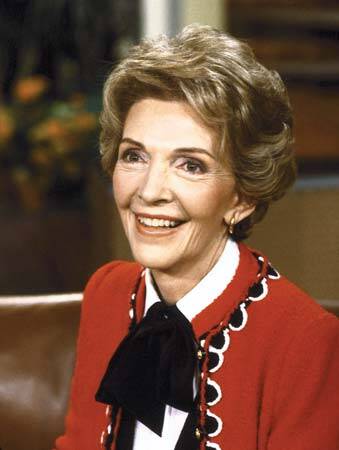When the announcement of former First Lady Nancy Reagan’s death at age 94 came on Sunday, it was noted that she died from “congestive heart failure,” following years of failing health. That was true in the physical sense. But what she died of was really of a broken heart, out of a longing for the love of her life, her husband, Ronald Reagan.
The day Ronald Reagan died, from the complications of Alzheimer’s disease, on June 5, 2004, was the day when Nancy Reagan really died. She could barely contain her emotions when, during the state funeral—with her son Ron and daughter Patti by her side—she put her hands atop the flag-draped coffin that contained the man she had loved with her whole being. With grief in her eyes, she beheld the American flag that she would soon be in possession of, as the widow of a former president. She knew that when he was given the diagnosis of that dreaded disease just a few years previously, she was slowly losing possession of him and of the memories they shared. The loss was plain—and clear for all to see.
She often said in describing herself that she was not an “I,” but part of a “we,” and that was how she saw her 52-year marriage to a man who, at various stages of his life, happened to be an actor, a citizen-politician, Governor of California and finally the 40th President of the United States. But none of that really mattered to her. When he died, the “we” of their relationship was broken in half; she had to become an “I” again.
Whatever side of the political divide you may find yourself a part of and no matter what you may have thought of Ronald Reagan’s politics, there is no question that it must be admitted that there was something special—something rare, really—about this couple who came from ordinary lives (he, literally born “above the store” in Tampico, Illinois in 1911, she, from a modest house in Queens, New York in 1921) would come across each other on a Hollywood movie lot and forge a bond that was unusual for its time and one which only grew stronger through the years and through many political adventures, culminating with residence in the White House.
When they met, he had been recently divorced because his actress-wife, Jane Wyman, could no longer tolerate his increasing political activism and union activities. He had been—so he thought—an up-and-coming actor, but circumstances and marital difficulties dictated otherwise. It was a forlorn man that Nancy Davis (the former Anne Frances Robbins) encountered when they met; it was thanks to her that the usual “perennial optimist” found his footing and his purpose in life once again.
Much has been written and said about Nancy Reagan and her impact upon her husband and through him, the country—some of it laudatory, a lot of denigrating. Like every First Lady who lived in the White House, Mrs. Reagan sought to leave her imprint not only on the physical building but on the society that building represented.
She didn’t have an easy time of it; by the time she became First Lady in 1981, the usual deference accorded to a presidential spouse was largely absent. Before long, anything she ever said and everything she ever did opened her up to critical scrutiny, which was often unpleasant and uncalled for. She was criticized for her designer dresses (especially for the “Nancy Red” which was her preferred color) or for the elaborate entertainments that were offered during a time when the nation’s economy wasn’t as healthy as it should have been. (In her defense, former First Lady Jacqueline Kennedy Onassis praised Mrs. Reagan for her work in bringing glamor and style back to the White House.)
Like previous First Ladies, she had a “cause” to promote; hers was drug and alcohol prevention (the “Just Say No” campaign). She was widely criticized for purchasing new china to be used for state dinners, at a cost of some $200,000. She was also criticized for being overly protective of her husband, even when she went as far as consulting an astrologer in the aftermath of the assassination attempt to ensure that her husband wouldn’t go out in public when possible dangers threatened. It seemed—to some quarters—that she couldn’t do anything right or that she was oblivious to others’ views and positions. Nevertheless, she went ahead and did as she saw fit—she was happy as long as it pleased her “Ronnie.” If it pleased him, it pleased her and that was what mattered.
Nancy Reagan wasn’t in that line of “activist” First Ladies, as Eleanor Roosevelt, Lady Bird Johnson or Betty Ford were; she was, to use the term to describe certain presidents, a “hidden hand” one—that is, she exerted her influence quietly, behind the scenes. This was most pronounced when it came to matters of personnel as well as policy. She had finely-tuned antennae when it came to personalities and politics, more so than her husband. She brooked no bones about expressing her displeasure to her husband and his top aides if she felt the person in question was more of a hindrance than a help to her husband and his goals. (The celebrated story of Chief of Staff Donald Regan hanging up the telephone on her said it all.)
And she was not averse to calling out others who she felt were giving her the short shrift by trying to take advantage of her or not respecting her position. The most prominent example of that was when during the during the Reagan-Gorbachev summit meeting when the leaders’ wives were put into a room to do a little summitry of their own. The wife of the Communist leader—no shrinking violet—decided to lord it over the seemingly demure and polite Nancy Reagan. Little did Raisa Gorbachev know with whom she was dealing with. Nancy Reagan knew the ins and outs of the political game as well as anybody, and she gave as good as she got. Mrs. Reagan let her have it: she fought back by saying, “Who does this dame think she is?” (Even the interpreters were startled by that outburst.) It was perhaps, her finest moment on the world stage when, in her own style, she defended the American way.
But of all things, it was her love for her husband that defined Nancy Reagan the most. Theirs was an intense love—and even that was ridiculed. Their marriage appeared to people as somewhat quaint; the husband-leader, the wife-follower, the adoring gaze she beheld him whenever she saw him (and that was regularly mocked). If she was dependent on him, he was equally—perhaps more—dependent on her.
Somehow, these two human beings, completely frail and fallible, yet powerful for a time, strode across history’s stage. Wherever they were, whether it was in the halls of the White House or the dirt road at the ranch, they walked together in love. That may not be as earth shattering as a peace treaty or the winning of an election, but such love is not a bad accomplishment in itself—and it was that love that was Nancy Reagan’s life’s work.








